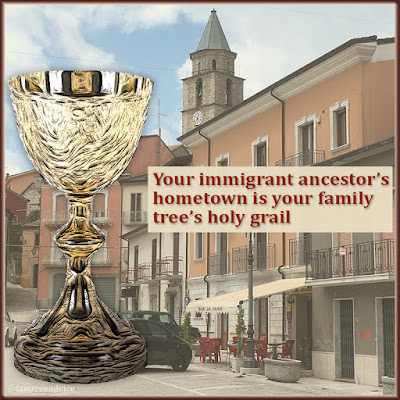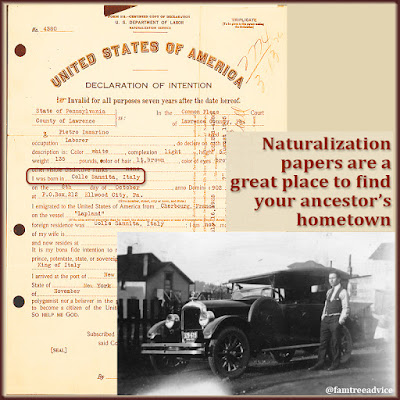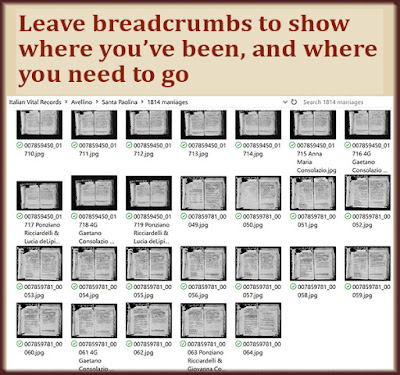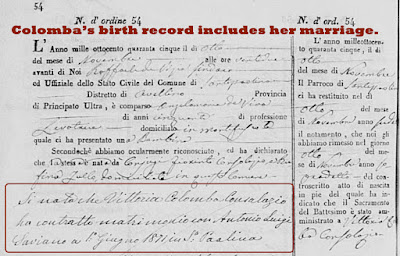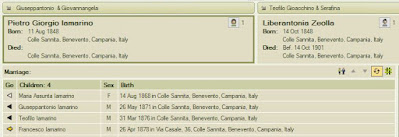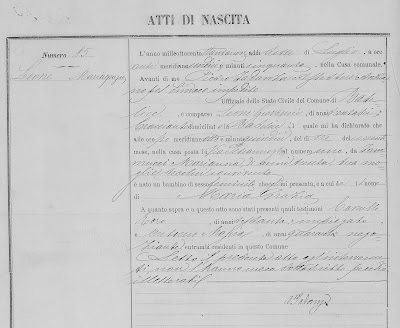 |
| When you find your ancestor's birth record, don't overlook the other gems in those vital records. |
Sometimes I dream I'm searching through old Italian vital records. I spend so much time knee-deep in vital records that it's only natural I would dream about them. The countless hours spent with these records have removed the foreign-language barrier completely.
You should explore all the vital records available from your ancestral hometowns, too. Here are 5 reasons why you should search for more than your direct ancestors in those records. Click each of the 5 titles to get the full story.
1. Don't Miss Out on Your Ancestors' Culture
I cringed when I learned my 2nd great grandmother Caterina was 23 years younger than her husband. Then I did a bit more digging. I found out Caterina was my 2nd great grandfather's second wife. And she was the same age as Nicola's eldest child from his 1st marriage!
Spending more time with this town's vital records, I realized a few things that hold true in all my towns:
- A widow or widower usually remarried in a hurry. Sometimes as soon as 2 months after their spouse died.
- A man's second wife was more likely to be much younger than him.
- When a bride and groom came from different towns, they usually married in her town and lived in his town.
- Each town registered a few abandoned babies each year. Someone might find a baby on a doorstep or on the side of the road. There was a special church window where you could leave a baby and no one would see you. These babies may have been born out of wedlock, but sometimes a woman chose to keep her baby.
- It was the mayor's job to name these foundlings. Their last name might:
- show the baby's status (Esposito, Abbandonato, etc.)
- refer to a local place name, like that of a river
- reflect their physical characteristic (Russo for a red-cheeked baby)
- or it may be a last name already found in the town.
I didn't fully understand these abandoned babies until I read a lot of their birth records. At first I thought my 60-year-old 5th great grandfather had another baby in 1809. Actually, he was about to step outside his home when he found the baby girl on his doorstep. That exact detail is noted on the birth record.
2. Discovering Life and Death Trends in Your Ancestral Hometown
I discovered a sad fact about my great grandmother Maria Rosa's hometown. Vital records showed a higher than usual infant mortality rate. How did I know it was higher than usual? Because I'd already reviewed the records from neighboring towns. A typical mid-1800s family in this town had 10 babies, but only 2 lived to adulthood.
That bit of information made it obvious why Maria Rosa and her siblings came to America. They all made a better life for themselves in New York, Ohio, and Pennsylvania.
3. What Do the Records Say About Your Ancestor's Town?
My 2nd great grandmother Colomba's hometown records told a very different story. While reviewing vital records, I realized that most marriage records included one out-of-towner. Colomba's husband (my 2nd great grandfather) came from a neighboring town to marry her. Colomba's own mother came from yet another town.
This led me to a second discovery. In my other ancestral hometowns, most men were farmers or laborers. But in Colomba's hometown, most men were merchants, notaries, and doctors. While this town is notable for its vineyards, it seemed to attract a more educated population.
So why did my 2nd great grandparents leave? It's possible Colomba's brothers inherited the family's land and property. Or her husband had his own ambitions.
4. Why All Siblings Are Critical to Your Family Tree
If you know when and where your 2nd great grandparents were born, you need to find all their siblings. Those siblings and their descendants will help you connect to many of your DNA matches.
I've found that one sibling's vital record can hold more clues than the others. No matter where your ancestor came from, vital records will vary depending on the year.
In some of my ancestral hometowns, birth records from 1866 to 1874 hold extra hints. For each of the baby's parents, you can find their full name, age, and their father's first name. That extra detail can help take your family tree back another generation.
5. Searching for Family in a New Town Takes Practice
I'm so familiar with the last names in my ancestral hometowns that I can see past the worst handwriting. But when I discovered my 3rd great grandmother in a new-to-me town, it was like starting from scratch.
This town's early records (starting in 1809) feature incredibly bad handwriting. I had to do a few things to feel confident about how to spell these new names. I started a spreadsheet to keep track of the last names I was seeing, then, for each name in the list I:
- Checked the Cognomix website for last name distribution in Italy. I made note of whether the name is still found in the town. If not, I noted the closest town that still has that name.
- Used a green highlight to show which names have high confidence in their spelling.
- Noted any alternative spellings. For example, sometimes a family uses the name Capua, but other times it's written as Capoa.
When I review this town's vital records, I check my spreadsheet to figure out what I'm looking at. Does that say Casassa? Oh, no, it's Casazza, and that's already in my list. Only by reviewing all the documents can I get comfortable with these new last names in my family tree.
Each of your ancestor's life stories depends in part on their family members. If you want to know your family history, be sure to broaden your search to the whole family and then some.
